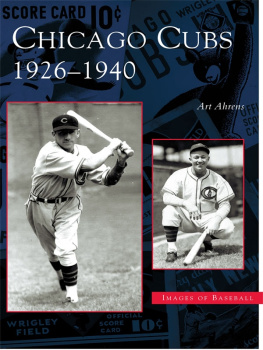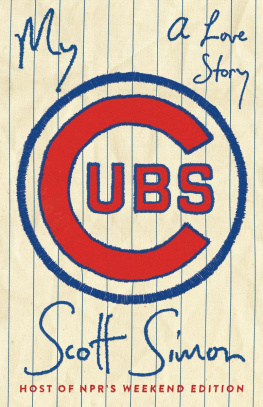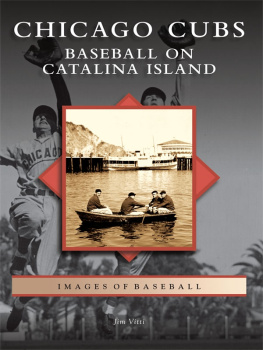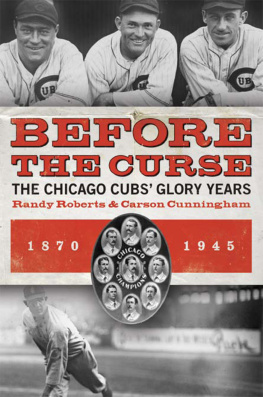Copyright 2009, 2016 by Al Yellon, Kasey Ignarski, and Matthew Silverman
All rights reserved. No part of this book may be reproduced in any manner without the express written consent of the publisher, except in the case of brief excerpts in critical reviews or articles. All inquiries should be addressed to Sports Publishing, 307 West 36th Street, 11th Floor, New York, NY 10018.
Sports Publishing books may be purchased in bulk at special discounts for sales promotion, corporate gifts, fund-raising, or educational purposes. Special editions can also be created to specifications. For details, contact the Special Sales Department, Sports Publishing, 307 West 36th Street, 11th Floor, New York, NY 10018 or .
Sports Publishing is a registered trademark of Skyhorse Publishing, Inc., a Delaware corporation.
Visit our website at www.sportspubbooks.com.
10 9 8 7 6 5 4 3 2 1
Cover design by Tom Lau
Cover photos: AP Images
Print ISBN: 978-1-61321-879-2
Ebook ISBN: 978-1-61321-887-7
Printed in the United States of America
Library of Congress Cataloging-in-Publication Data
Yellon, Al.
Cubs by the numbers : a complete team history of the Chicago Cubs by uniform number / Al Yellon, Kasey Ignarski & Matthew Silverman.
p. cm.
Previous ISBN 978-1-60239-372-1
1. Chicago Cubs (Baseball team)History. 2. Baseball uniformsNumbersIllinoisChicago. I. Ignarski, Kasey. II. Silverman, Matthew. III. Title. IV. Title: Complete team history of the Chicago Cubs by uniform number.
GV875.C6Y45 2009
796.357640977311dc22
2009000434
Al:
To my dad, who had no idea what hed be starting, my lifelong love for the Cubs, when he took me to Wrigley Field for the first time on July 6, 1963.
And to Bob Romain, friend and great Cubs fan, who passed away suddenly on October 3, 2008, and never had a chance to read this history of the team he loved.
Kasey:
To Wally, Shelby, Al, and Johnmy ballpark family.
Matt:
For the diehards.
CONTENTS
FOREWORD
Numbers are such an integral part of baseball and Wrigley Field, its hard to believe there was a time when the Cubs ran onto the field with blank shirts on their backs. Glad I wasnt announcing or trying to keep score back then. I can only imagine what spring training games must have been like with all those substitutions and no numbers.
The Cubs had been playing in the National League for more than fifty yearstheyd helped start the league in 1876before they finally sewed numbers on their uniforms in the middle of the 1932 season. This is the story of everyone thats hitched up the digits. The Stan Hacks, the Charlie Roots, the Phil Cavarrettas of the world, those you might have been able to tell without a numberCubs fans have always been sharpbut the Dom Dallessandros and Harry Chitis of the world, they could now stand and be counted. And theyve kept on counting; more than 1,500 Cubs since then have worn numbers. Only one player or manager or coach at a time can wear a number, though some have traded in numbers often enough youd think they wanted to change that rule, too. Seems that as soon as one person gets traded or demoted or retires or just feels like a numeric change is needed, their number is right back in circulation waiting for the next in line. Unless, of course, youre talking about numbers 10, 14, 23, 26, or 31, the only numbers the Cubs have retired.
Can you imagine Ron Santo wearing a number other than 10? Or Billy Williams wearing a number besides 26? Well, they both did. Yes, my broadcast partner for fifteen years came into the world as a Cub wearing #15 in 1960. Billy wore #41 that year. Hed worn #4 the previous season for his first sweet swings at Wrigley. It wasnt until 1961 that both Ronnie and Billy settled into the numbers that now fly on the flagpoles on each side of fair territory at Wrigley Field. You didnt know that? Well, theres a lot about the Cubs youll learn from this fun book.
This isnt just some dry account of numbers worn through the yearsthough its got everybody whos donned Cubs blue since 32but there are fun to read stories and facts about both your favorites and guys you never heard of. Anyone whos worn a Cubs uniform even for one inning is included here, people whose names you should get to know if you call yourself a Cubs fan. And millions do.
But the number thats fascinated me since I first learned to count by reading the backs of baseball cards as a kid is #3. Three seems to come up constantly in baseball. Three outs, three strikes, three-game series, .300 hitters, and three men on the bases, which always makes your heart beat a little faster whether its your guy that put them there or your guy at the plate trying to bring them home.
Count yourself lucky that the Cubs now have a book that tells the history of this great franchise, one number at a time.
And away we go
Pat Hughes
September 2008
INTRODUCTION
Even before the Cubs wore numbers on their uniforms, they had made three numbers famous: 6-4-3. Tinker to Evers to Chance was one of the great infields of its day, but it was a short ditty penned by Franklin P. Adams, a transplanted Chicagoan living in New York, that provided meter and made their names eternal, transforming these ballplayers into a trio of bear cubs, fleeter than birds. Oddly, in the nine seasons (190210) that these three made up that famous DP combination, not once did the Cubs lead the National League in double plays. It just must have seemed so to Adams and the New York Giants, the team the Cubs so often kept from the World Series.
In the years since Peerless Leader Frank Chance led the Cubs to no fewer than 90 winsfour times cracking 100, with four pennants and two world championshipsin just seven full seasons at the helm, the Cubs have had to earn everything theyve gotten. They won two pennants from Chances acrimonious exit in 1912 until the unpleasant removal of another future Hall of Famer, Rogers Hornsby, from the managers chair during the 1932 season. Charlie Grimm took over on July 13. By then, the Cubs were wearing numbers on their back. So was the whole National League. The Cubs dialed it up under Jolly Cholly and won the pennant.
Eighty-four years later, these numbers are like an epic poem through four generations of Cubs, from the days when no team played night games, to the present day, now more than a generation after Wrigley Field finally switched them on. Each player, each number, is linked in a chain through the years. Through the 2015 season, 1,405 players have buttoned up or pulled over a jersey with Cubs on the front and a number on the back. That number increases by 117 when counting managers and coaches who never suited up as Cubs players, bringing the grand total to 1,522 numbered personnel in franchise history. Of course, that number will already be obsolete by the time you read this. The numbers just keep rolling on.
Lists of every player and their numbers are not new Baseball by the Numbers (by Mark Stang and Linda Harkness), Now Batting, Number (by Jack Looney), and team media guides have trod this ground before usbut the tale of who these people were behind the numbers and connecting them by the often arbitrary selection of uniform numbers, establishes a new relationship among players who have heretofore had little more in common than their home park and the C on their hat. Nationalities, religions, and player ratings aside, we line them up toe to toe from Woody English, the original #1, to Todd Hundley, who doubled father Randys fun (but not his reliability) in #99. Pitchers, shortstops, and right fielders gather together at nearly every stop north of #10. Larry Biittner and Fritzie Connally (yes, there really was a major league player known as Fritzie) don #26 during the brief interludes between 1961 and 2001 when Billy Williams isnt wearing it. Hall of Famer Billy, incidentally, wore a Cubs uniform for 31 seasons, 16 as a player and 15 as a coach, more than any other single individual. Follow the Wrigley brick road to #32: Coaker (Triplett), and (Craig) Lefferts, and Bobs (Carpenter and Schultz), Rich Nye!











